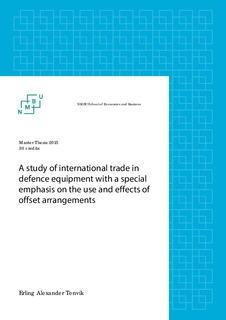A study of international trade in defence equipment with a special emphasis on the use and effect of offset arrangemente
Master thesis
Permanent lenke
http://hdl.handle.net/11250/295867Utgivelsesdato
2015-08-10Metadata
Vis full innførselSamlinger
- Master's theses (HH) [1072]
Sammendrag
1. There is a great deal of uncertainty in terms of who benefits from offset arrangements. There is no clear evidence that the offsetting transactions fully compensate the buyer of military equipment for the increased costs offsets entail.
2. It is not clear how offsets add to the final bill for the buyer, but authoritative studies indicate that the mark up is between 10 and 30%. However, this will depend on the type of equipment, the structure of the deal and the relational dynamics between the parties involved.
3. The implementation of EU Directive 2009/81 does not seem to have enhanced cross border trade in military equipment inside EU. To the extent the EU Directive has had an impact it is more in form & terminology and less in content and increased competition.
4. The industry players, particularly from smaller countries, still insist on offsets or similar arrangements to be in place as they see it as the best way of securing market access to large markets.
5. The trade in defence equipment has slowed down in the EU, but has increased significantly in South East Asia and the Middle East, which are regions very much in favour of offsets. The use of offsets or similar arrangements are therefore not likely to decrease.
6. The spill over benefits to the general economy is significantly overestimated by developing nations.
